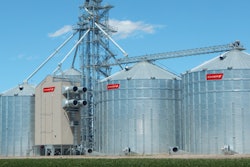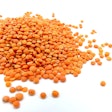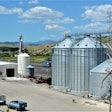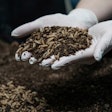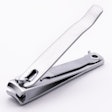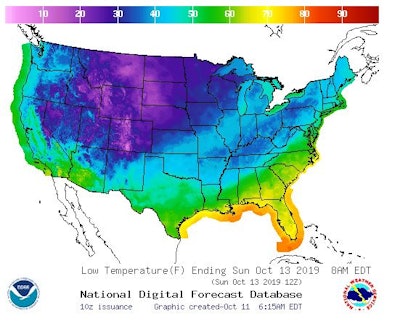
A challenging soybean harvest this fall is raising many storage and drying questions, according to Ken Hellevang, an agricultural engineer with North Dakota State University Extension.
According to the National Agricultural Statistics Service on Oct. 6, the percentage of soybeans dropping leaves was 92% in North Dakota, 80% in Minnesota, 78% in South Dakota, 68% in Iowa, 69% in Michigan, 86% in Nebraska and 60% in Wisconsin.
The percentage of beans harvested was less than 10% in those states.
“The impending snow and cold across the Plains states likely will freeze the soybeans in some states and will impede maturity and drying across much of the region,” Hellevang says. “Soybeans that freeze before maturity may have a green color and will be smaller than mature beans after drying.
“Also, field drying may be slower,” he notes. “Beans may change color during dry-down and through time in storage. Green-colored beans will be discounted due to the required additional processing of the oil.”
Shatter losses have been shown to increase significantly when mature beans undergo multiple wetting and drying cycles. Moisture content can increase by several points with an overnight dew or rain event, and it can decrease by several points during a day with low humidity and windy conditions.
Soybean moisture variation may lead to storage losses. Operating an aeration fan will help move moisture from wet beans to drier beans, Hellevang says. Air going past wet beans picks up moisture, and that moisture will transfer to drier beans as the air goes past them.
Moisture movement will be minimal without aeration airflow. Hellevang suggests initially running the fan longer than is required to cool the beans to even out the moisture content. The moisture will not be all the same, but it should become more uniform.
Soybeans at 11% moisture have similar storage characteristics as wheat or corn at about 13.5% moisture, so 16% moisture soybeans might be expected to store the same way as about 18.5% moisture corn or wheat. Beans at 18% moisture would be similar to about 20.5% moisture corn.
Drying soybeans
自然空气干燥的箱子里的数量occur in northern states in late October and early November is limited. The equilibrium moisture content of soybeans for air at 40 degrees and 70% relative humidity is about 13.5%, so drying soybeans with moisture contents above 13.5% would be expected with this air condition.
However, the drying rate will be slow at typical in-bin drying airflow rates. An airflow rate of 1 cubic foot per minute per bushel (cfm/bu) is expected to dry 18% moisture soybeans in about 70 days. With an airflow rate of 1.5 cfm/bu, the drying time is reduced to about 47 days.
The drying time for 16% moisture soybeans is slightly less - about 60 days at an airflow rate of 1 cfm/bu. Adding supplemental heat to raise the air temperature by 5 degrees will permit drying 16% soybeans to about 11% moisture in about 55 days. Increasing the airflow rate proportionally reduces the drying time but greatly increases the needed fan horsepower.
For a soybean depth of 22 feet, each 1,000 bushels of soybeans will require about 1 horsepower of fan to achieve an airflow rate of 1 cfm/bu. Achieving an airflow rate of 1.25 cfm/bu will require about 1.6 horsepower per 1,000 bushels, and an airflow rate of 1.5 cfm/bu will need about 2.5 horsepower per 1,000 bushels.
The type of fan greatly affects the airflow provided per horsepower, so use a fan selection program. One is linked from the NDSU grain drying and storage website (https://www.ag.ndsu.edu/graindrying).
The moisture-holding capacity of air is reduced at lower air temperatures, Hellevang says. As average air temperatures drop below 40 degrees, natural-air drying becomes inefficient and not economical. Adding heat causes the beans on the bottom of the bin to dry to a lower moisture content and would increase drying speed only slightly.
Hellevang recommends cooling the soybeans to between 20 and 30 degrees for winter storage and completing the natural-air drying in the spring. Start drying in the spring when outdoor temperatures are averaging about 40 degrees.
Recommended drying temperatures
Soybeans can be dried in a high-temperature dryer, but the dryer temperature needs to be limited to minimize damage to the beans. Refer to the dryer manufacturer’s recommendations for maximum drying temperature.
Typically, the maximum drying temperature for nonfood soybeans is about 130 degrees. Even at that temperature, some skins and beans will be cracked. Keep the air relative humidity above 40% to minimize cracking of food grade or seed beans.
Roughly, with each 20-degree increase in drying temperature, the air relative humidity is reduced to one-half, Hellevang notes. Air at 50 degrees and 80% relative humidity will have a relative humidity of about 40% when heated to 70 degrees. He recommends monitoring the soybean seeds coming from the dryer and managing the dryer temperature based on the amount of damage occurring.
食品级大豆和大豆种子不能有damage to the seed coat, so natural-air or low-temperature drying is the preferred drying method, Hellevang says. Seed beans should be dried at temperatures below 110 degrees.
Reducing fire risks when drying
Hellevang also warns of the risk of fires when drying soybeans. Soybean pods and other trash can accumulate in the dryer and become combustible.
To reduce the risk of fires:
- Assure that trash does not accumulate in the dryer.
- Make sure soybeans continue to flow in all sections of the dryer.
- Monitor the dryer continuously.
- Clean the dryer frequently to reduce the potential for debris to combust.
Soybeans at 11% moisture have similar storage characteristics as wheat or corn at 13.5% moisture, so an allowable storage time chart for cereal grains can be used to estimate allowable storage times for soybeans. For example, soybeans at 18% moisture content would be similar to cereal grains at 20.5% moisture, so soybeans would be expected to have an allowable storage time of about 45 days at 50 degrees.
The allowable storage time is reduced to about 20 days at 60 degrees and extended to about 85 days at 40 degrees.
NDSU Agriculture Communication:
Source: Ken Hellevang, 701-231-7243,[email protected]
Editor: Ellen Crawford, 701-231-5391,[email protected]








